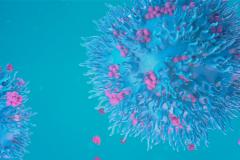A new study led by investigators at BC Children’s Hospital has identified a metabolic marker that can flag whether a patient is likely to develop a disease brought on by lifesaving bone-marrow transplants. Their results were recently published in Blood.
Chronic graft versus host disease occurs when a donor’s stem cells reject the recipient’s body, causing a disease that can affect many different organs.

Dr. Kirk Schultz, who headed the international team that was funded by the Canadian Institutes of Health Research (CIHR), says BC Children’s is the world leader in investigating how to improve the understanding of and treatment for chronic graft versus host disease.
“We hope the discovery of this biomarker is the first step in developing new ways to diagnose and treat chronic graft versus host disease,”
said Dr. Schultz, an investigator with the Michael Cuccione Childhood Cancer Research Program at BC Children’s Hospital and a professor in the division of hematology and oncology in pediatrics at the University of British Columbia. “It’s an exciting step forward.”
Schultz and international colleagues collected and analyzed blood samples from all six bone marrow transplant centres in Canada, 20 in the United States and another in Austria, analyzing plasma metabolites on 222 evaluable pediatric subjects.
They found a consistent elevation of the molecule alpha-ketoglutaric acid in the blood of patients before and during the onset of chronic graft versus host disease. This acid emerged as the single most significant metabolite associated with the disease.
Clinicians perform approximately 2,000 stem cell bone marrow transplants per year in Canada, 200 of them in children. Sixty per cent of these kids have cancer and the other 40 per cent are living with rare life-threatening diseases.
“Bone marrow transplant often represents the only hope for these kids,” said Dr. Schultz.
“We’ve got to make bone marrow transplant safe. One of the goals of this study is getting closer to giving kids long, safe healthy lives.”
Of patients who receive a bone marrow transplant, approximately 30 to 70 per cent develop chronic graft versus host disease. This disease can cause lifelong problems including walking difficulties, lung damage that can necessitate a lung transplant, vision problems and a susceptibility to infections.
“For children with the severe forms of chronic graft versus host disease, there’s a fatality rate of around 20 per cent over the next 20 years,” said Dr. Geoffrey Cuvelier, co-senior author of the study.
Those who survive chronic graft versus host disease report the condition significantly impacts the rest of their lives.
“We’re hoping that with early tests, we can treat it before it gets serious,”
adds Dr. Cuvelier, head of the department of pediatric oncology/hematology, with CancerCare Manitoba. "Chronic graft versus host disease leads to irreversible scarring in the skin and reversing it once the damage has happened is much more difficult than preventing it.”
A graduate student is already exploring whether scientists can use the newly discovered biomarker to design new treatments for the complications of chronic graft versus host disease. Meanwhile, researchers are enrolling 350 children in an international trial with the hope of duplicating their results in preparation for a clinical test. They’ve also developed a test that combines the newly discovered biomarker with other biomarkers to predict who’s at risk for developing chronic graft versus host disease so they can intervene before it starts.
“One of the things that’s clear is catching it earlier will prevent or minimize this disease,” said Dr. Schultz.
The research team included Dr. Divya Subburaj, Dr. Bernard Ng, Dr. Amina Kariminia, Dr. Sayeh Abdossamadi, Ms. Madeline Lauener, Dr. Jacob Rozmus, Dr. Elena Ostroumov and Dr. Ramon Klein Geltink.
A Canadian Institutes of Health Research team grant and a grant from The Leukemia & Lymphoma Society of Canada provided the bulk of the funding for this study.




